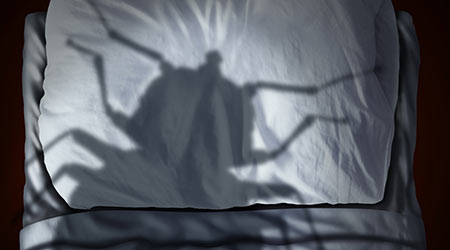
For the second year in a row, Baltimore tops Orkin’s Top 50 Bed Bug Cities list. New York fell four spots, while Dallas-Fort Worth joined the top 10. San Diego and Albany rejoin the list, after falling out of the top 50 in 2017, and New Orleans and Flint, Mich. join the list for the first time ever while Orlando has fallen off the list.
The list is based on treatment data from the metro areas where Orkin performed the most bed bug treatments from December 1, 2016 – November 30, 2017. The ranking includes both residential and commercial treatments.
1. Baltimore
2. Washington, D.C.
3. Chicago
4. Los Angeles (+2)
5. Columbus, Ohio
6. Cincinnati (+2)
7. Detroit
8. New York (-4)
9. San Francisco-Oakland-San Jose
10. Dallas-Fort Worth (+5)
11. Indianapolis
12. Philadelphia
13. Atlanta (+3)
14. Cleveland-Akron-Canton, Ohio (-1)
15. Raleigh-Durham, N.C. (-3)
16. Richmond-Petersburg, Va. (-5)
17. Houston
18. Norfolk-Portsmouth-Newport News, Va. (+2)
19. Charlotte, N.C. (-3)
20. Buffalo, N.Y. (-2)
21. Knoxville, Tenn.
22. Nashville, Tenn. (+1)
23. Grand Rapids-Kalamazoo-Battle Creek, Mich. (+4)
24. Pittsburgh
25. Greenville-Spartanburg, S.C.-Asheville, N.C.
26. Champaign-Springfield-Decatur, Ill. (+4)
27. Phoenix (-1)
28. Denver (-6)
29. Milwaukee
30. Hartford-New Haven, Conn. (+1)
31. Charleston-Huntington, W.Va. (+5)
32. Boston (-4)
33. Syracuse, N.Y. (+7)
34. Dayton, Ohio (-2)
35. St. Louis (+2)
36. Seattle (-2)
37. Miami-Ft. Lauderdale, Fla. (+9)
38. Flint-Saginaw-Bay City, M.I. (new to list)
39. Omaha, N.E. (-6)
40. Cedar Rapids-Waterloo-Dubuque, Iowa (-2)
41. San Diego (new to list)
42. Lexington, Ky. (+1)
43. Honolulu, Hawaii (+5)
44. Louisville, Ky. (-3)
45. Las Vegas (+4)
46. Greensboro-High Point-Winston Salem, N.C. (-4)
47. New Orleans (new to list)
48. Myrtle Beach-Florence, S.C. (-9)
49. Tampa-St. Petersburg, Fla. (-14)
50. Albany-Schenectady-Troy, N.Y. (new to list)
“The number of bed bug infestations in the United States is still rising,” says Dr. Tim Husen, an Orkin entomologist. “They continue to invade our homes and businesses on a regular basis because they are not seasonal pests, and only need blood to survive.”
Bed bugs are always in motion. They travel from place to place with ease, including luggage, clothing and other belongings. In addition to single family homes, bed bugs can be found in apartments, hotels, hospitals and public places like daycare centers, public transit, schools and offices.
According to a 2015 “Bugs without Borders Survey” by the National Pest Management Association, the top three places where pest professionals report finding bed bugs are apartments/condominiums (95 percent), single-family homes (93 percent) and hotels/motels (75 percent).
“Any type of home is prone to bud begs. It has nothing to do with sanitation. We have treated for bed bugs everywhere, from newly built upscale homes to public housing,” Husen says.
Bed bugs are capable of rapid population growth with an adult female laying two to five eggs per day (up to 500 in her lifetime), often making treatment challenging. Adult bed bugs are about the size of an apple seed and are typically reddish brown. Their small size and ability to hide make them difficult to see during the day, so it’s important to look for the black, ink-like stains they can leave behind.
Bed bugs cannot be completely prevented so early detection is critical. To help detect bed bugs, Orkin recommends the following:
• Survey areas for signs of an infestation. Be on the lookout for tiny, ink-colored stains on mattress seams, in soft furniture and behind headboards.
• Lift and look in bed bug hiding spots: the mattress, box spring, and other furniture, as well as behind baseboards, pictures and even torn wallpaper.
• Decrease clutter to make it easier to spot bed bugs on your own or during professional inspections.
• Dry potentially infested bed linens, towels and curtains on the hottest temperature allowed for the fabric.
Bed bugs are an elusive threat, as they can reproduce quickly and travel on your belongings, so it’s critical to detect and treat for them as early as possible. Anyone who suspects a bed bug infestation should contact a pest management professional immediately.

 The Down and Dirty on Cleaning in Virus Season
The Down and Dirty on Cleaning in Virus Season How Surfactant Use is Expanding in Commercial Cleaning
How Surfactant Use is Expanding in Commercial Cleaning Clean Buildings Conference
Clean Buildings Conference